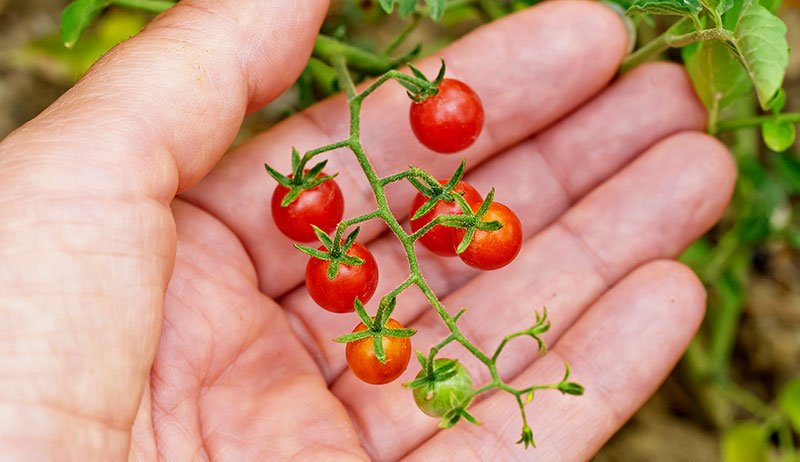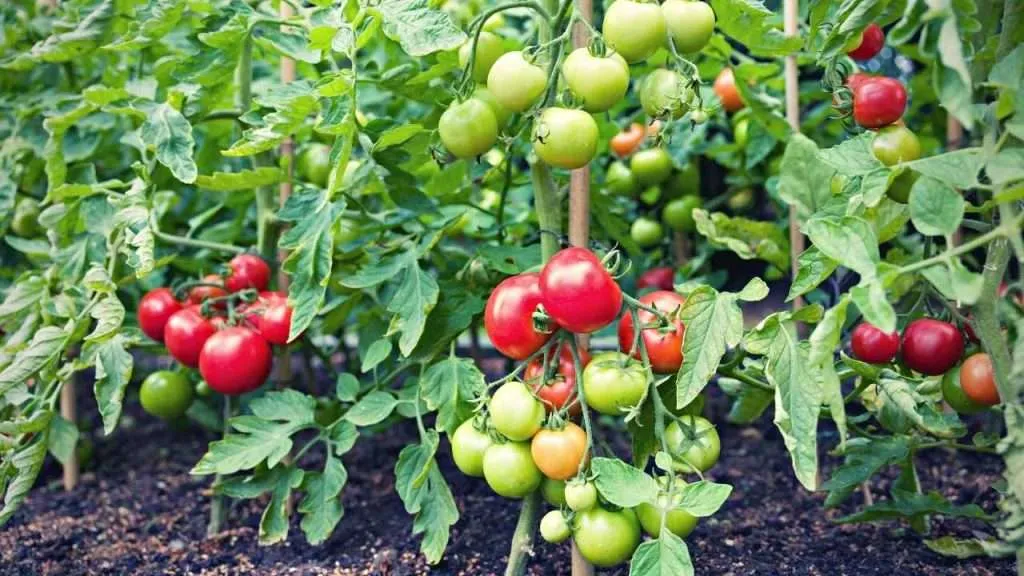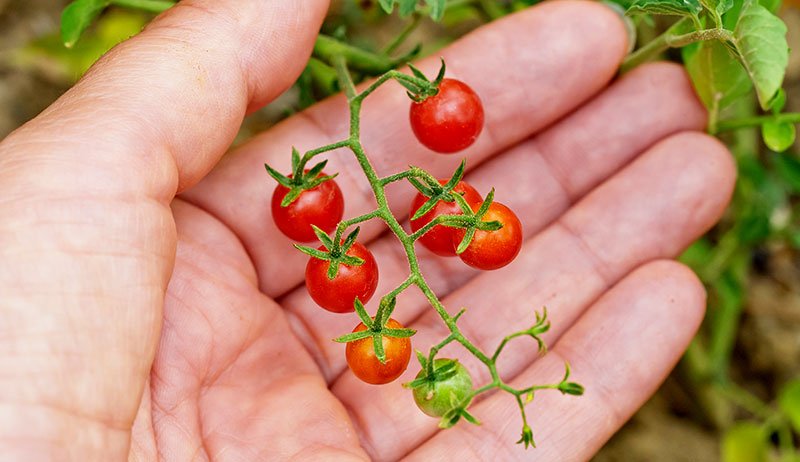In the realm of botany, the widespread tomato plant has long intrigued or puzzled individuals with its intriguing blend of delectable fruits and possibly harmful components. Delving into the heart of this botanical curiosity, this article explores the question: What part of the tomato plant is poisonous? By carefully examining the toxicity levels of various components, such as leaves and stems, this investigation sheds light on the potential dangers lurking within this seemingly harmless plant. So, prepare to embark on a journey through the captivating world of tomatoes and uncover the truth behind their hidden threats.

Solanine: The Poisonous Compound in Tomato Plants
Tomato plants (Solanum lycopersicum) are popular garden plants cultivated for their delicious and nutritious fruits. However, it is crucial to be aware of the potential toxicity of various parts of the tomato plant. One of the main toxic compounds found in tomato plants is solanine. Solanine is a glycoalkaloid that belongs to the family of compounds known as steroidal alkaloids. It is primarily concentrated in the leaves, stems, roots, flowers, and unripe green fruits of the tomato plant. In this article, we will explore the formation and toxicity of solanine in different parts of the tomato plant, as well as the potential risks associated with consuming these plant parts.
What is Solanine?
Solanine, a naturally occurring chemical compound in the nightshade family of plants, acts as a defense mechanism against herbivores. It is particularly abundant in the green parts of tomato plants, where its bitter taste and toxic properties deter animals from consuming them. Solanine has the ability to disrupt cell membranes and inhibit certain enzymes in the body. Ingesting high concentrations of solanine can lead to adverse health effects, ranging from mild gastrointestinal discomfort to more severe symptoms such as vomiting, diarrhea, and even paralysis in extreme cases.

Formation of Solanine in Tomato Plants
The synthesis of solanine in tomato plants is influenced by various factors, including genetics, environmental conditions, and plant maturity. As the tomato plant grows and develops, solanine starts to accumulate in certain plant parts. The compound is produced through a series of enzymatic reactions, primarily in the green tissues of the plant. These reactions involve the conversion of certain precursor compounds, such as solanidine, into solanine. Under normal circumstances, solanine levels remain low in ripe tomatoes, but they can increase significantly in the unripe green fruits and other plant parts.
Toxicity in Tomato Leaves
Upper Leaves vs. Lower Leaves
Tomato leaves contain varying levels of solanine, depending on their position within the plant. Upper leaves, which receive more sunlight and generally have a higher chlorophyll content, tend to contain lower levels of solanine compared to the lower leaves. This is because solanine production is negatively regulated by light. Lower leaves, which are shaded by the upper canopy, have higher solanine concentrations as they receive less direct light exposure. It is important to note that while solanine levels in tomato leaves can be toxic, the concentration is generally not high enough in mature leaves to cause significant harm upon consumption.
Amount of Solanine in Tomato Leaves
The exact concentration of solanine in tomato leaves can vary widely, depending on factors such as plant variety, growing conditions, and plant maturity. Generally, the concentration of solanine in tomato leaves is higher in younger plants and decreases as the plant matures. Studies have shown that solanine levels in tomato leaves can range from 1 to 50 mg per 100 grams of fresh weight. Consuming large quantities of tomato leaves, especially those from immature plants, can potentially lead to an accumulation of solanine in the body, resulting in toxicity.

Toxicity in Tomato Stems
Presence of Solanine in Tomato Stems
Similar to tomato leaves, tomato stems also contain solanine, although in lower concentrations. The solanine content in stems is generally lower than that in the leaves and is primarily concentrated in the green, unripe parts of the stem. As the tomato plant matures, the solanine concentration in the stems decreases. It is important to note that while the solanine levels in tomato stems may not be as high as in other plant parts, it is still advisable to exercise caution when consuming them.
Potential Dangers of Consuming Tomato Stems
Consuming large quantities of tomato stems, particularly those from immature plants, can potentially lead to the accumulation of solanine in the body. While the solanine content in tomato stems is relatively low compared to some other parts of the plant, it can still pose a risk, especially to individuals with sensitivity or compromised health conditions. Symptoms of solanine toxicity resulting from excessive consumption of tomato stems may include gastrointestinal discomfort, nausea, and vomiting. Therefore, it is advisable to remove the stems before consuming tomatoes, especially if you have concerns about solanine toxicity.
Toxicity in Tomato Roots
Solanine Content in Tomato Roots
Tomato roots, like other plant parts, contain solanine, although their solanine content is relatively low compared to the leaves and stems. The majority of solanine in tomato roots is present in the outer layers of the root, particularly in the epidermis. As with tomato leaves and stems, the solanine level in tomato roots decreases as the plant matures. However, it is important to note that the solanine content may still be present in quantities that pose a risk if consumed excessively.
Risks Associated with Tomato Roots Consumption
While consuming small amounts of tomato roots is generally considered safe, large quantities may lead to the accumulation of solanine in the body. It is important to exercise caution when consuming tomato roots, especially those from immature plants or plants that have been exposed to unfavorable growing conditions. Symptoms of solanine toxicity resulting from excessive consumption of tomato roots may include gastrointestinal distress, such as abdominal pain and diarrhea. If you plan to consume tomato roots, ensure they are thoroughly washed and cooked to reduce the potential risk of solanine toxicity.

Toxicity in Tomato Flowers
Potential Toxicity of Tomato Flowers
Tomato flowers, although generally not consumed as a part of traditional culinary practices, contain solanine, albeit in relatively small amounts. The solanine content in tomato flowers is significantly lower compared to other plant parts, such as the leaves and green fruits. However, in rare cases where tomato flowers are intentionally consumed, especially in larger quantities or in concentrated forms, there is a potential risk of solanine toxicity.
Effects of Consuming Tomato Flowers
The consumption of tomato flowers, especially in large amounts, may lead to adverse effects due to the presence of solanine. These effects can vary depending on an individual’s sensitivity and the amount consumed. Symptoms of solanine toxicity resulting from excessive consumption of tomato flowers may include gastrointestinal discomfort, headache, and in rare cases, allergic reactions. As a precautionary measure, it is advisable to avoid consuming tomato flowers, focusing instead on the consumption of ripe fruits where solanine levels are significantly lower.
Toxicity in Tomato Green Fruits
Solanine Levels in Green Tomatoes
Green, unripe tomatoes are known to have higher solanine levels compared to their ripe counterparts. As tomatoes ripen, the concentration of solanine decreases. The green parts of the unripe tomato, including the skin and flesh, contain higher amounts of solanine compared to the ripe fruits. Consequently, the unripe green tomatoes pose a higher risk of solanine toxicity when consumed in significant amounts.
Health Risks of Eating Green Tomatoes
Consuming large quantities of green tomatoes can potentially lead to solanine poisoning. The symptoms of solanine toxicity resulting from excessive consumption of green tomatoes may include gastrointestinal discomfort, such as nausea, vomiting, and abdominal pain. In extreme cases, consuming very large amounts of unripe tomatoes may lead to more severe symptoms, including neurological effects such as headache, dizziness, and even paralysis. To minimize the risk of solanine toxicity, it is advisable to consume ripe tomatoes rather than their green counterparts.

Toxicity in Tomato Ripe Fruits
Red Tomatoes vs. Green Tomatoes
As tomatoes ripen and transition from green to red, the concentration of solanine decreases significantly. Ripe tomatoes have much lower solanine levels compared to their unripe green counterparts. This decrease in solanine content occurs as part of the natural ripening process, and it is a result of enzymatic changes within the tomato fruit. Therefore, ripe red tomatoes pose a minimal risk of solanine toxicity when consumed in typical culinary quantities.
Safety of Consuming Ripe Tomatoes
Consuming ripe tomatoes is generally considered safe and provides numerous health benefits. Ripe red tomatoes have been a staple food in various cuisines around the world, offering essential nutrients like vitamins A and C, lycopene, and various antioxidants. The solanine content in ripe tomatoes is highly unlikely to reach toxic levels unless consumed in excessively large quantities or in rare cases of individual sensitivities. However, it is still important to handle and prepare tomatoes properly to minimize any potential risks associated with other plant parts.
Handling and Preparing Tomato Plant Parts
Proper Care when Handling Tomato Leaves
When handling tomato leaves, it is important to take certain precautions to minimize exposure to solanine. Direct contact with tomato leaves may cause skin sensitivity or irritation in some individuals. It is advisable to wear gloves when working with tomato plants, especially if you have known sensitivities or allergies. In addition, proper hand hygiene should be practiced after handling tomato leaves, as solanine present on the leaves can transfer to the skin and potentially cause irritation or other adverse effects upon contact with sensitive areas.
Removing Tomato Leaves and Stems Safely
To reduce the solanine content in tomatoes and minimize any potential risks associated with consumption, it is recommended to remove the leaves and stems before cooking or eating the fruits. This process can be easily achieved by plucking off the leaves from the stem and cutting off any green parts, including the stem attached to the tomato fruit. By removing these plant parts, you can significantly reduce your exposure to solanine and enjoy the ripe, delicious tomatoes with peace of mind.
Exceptions and Variations
Non-toxic Tomato Varieties
While solanine toxicity may be a concern with certain tomato plant parts, it is important to note that not all tomato varieties are equally toxic. Some tomato varieties have been specifically bred and selected for lower solanine content, making them less toxic. These non-toxic varieties, such as certain heirloom or hybrid tomatoes, have been developed over generations of cultivation to minimize the risk of solanine toxicity. When selecting tomato plants or seeds, it can be helpful to look for varieties that are known for their low solanine content if you have concerns about solanine toxicity.
Contamination and Pesticide Risks
In addition to solanine toxicity, it is essential to be aware of potential risks associated with contamination and pesticides in tomatoes. Improper handling, storage, or growing conditions can lead to bacterial contamination, such as Salmonella or Escherichia coli (E. coli). Pesticide residues may also be present on conventionally grown tomatoes. To reduce these risks, it is advisable to consume organically grown tomatoes and follow proper food safety practices, such as washing the tomatoes thoroughly before consumption.
Conclusion
While tomatoes are generally safe and nutritious to consume, it is crucial to be aware of the potential toxicity of certain parts of the tomato plant. Solanine, a toxic compound present in various plant parts, such as leaves, stems, roots, flowers, and unripe green fruits, can cause adverse health effects if consumed in large quantities. However, with proper handling and preparation, the risks associated with solanine toxicity can be significantly minimized. By removing the leaves and stems, and focusing on consuming ripe red tomatoes, you can enjoy the health benefits and deliciousness of tomatoes while ensuring your safety and well-being.



